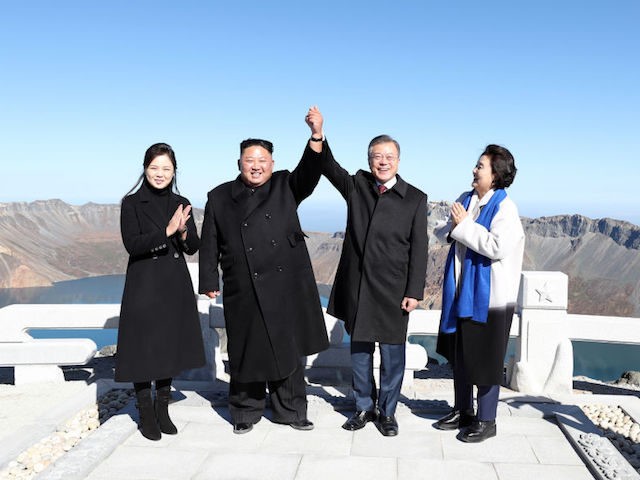President Moon Jae-in and wife Kim Jung-sook made a final stop on their three-day trip to North Korea on Thursday to climb Mount Paektu, the highest peak in the Koreas.
Mt. Paektu is considered a holy patriotic site in the South for being the mythical birthplace of the Korean people, and in the North for being the mythical birthplace of the Kim dynasty.
Communist dictator Kim Jong-un reportedly invited Moon, who had made several comments in public about a lifelong dream to climb the active volcano, and his wife to travel with him to the top of Mount Paektu and gaze upon the Cheonji crater lake. South Korean newspaper JoongAng Ilbo reported on Thursday that the two heads of government and their wives traveled to the mountain early Thursday. North Korean authorities arranged for “nearly 1,000 North Korean citizens holding flowers” to cheer them on to the mountain “as some 100 members of a military band played.”
When they reached the top of the mountain, Kim and Moon held their hands aloft and cheered, taking photographs in front of the Cheonji lake. Photos show Moon later filling a bottle with water from the lake to take home.
Pool reports of the event quoted Kim Jong-un as telling Moon that he wanted to “write a new history between the North and South” and hoped to see more South Koreans visit the mountain in the future. He also reportedly boasted to Moon that “Chinese people envy us because they can’t reach the crater lake from China.”
“Only a few people have come today, but in the future, South Koreans and our people living abroad should come see Mount Paektu as well,” he said, adding that Mount Paektu has become a “mountain of longing” ever since both Koreas were separated by war because those in the South are unable to physically reach it.
Following Moon and Kim’s visit, the South Korean pop singer Ali – one of an entourage of over 200 artists, politicians, and businessmen Moon brought with him to North Korea – performed a rendition of the traditional Korean song “Arirang” atop the mountain.
Mount Paektu lies on the border between North Korea and China and is accessible from the Chinese side, where many South Korean tourists choose to visit from. Reuters notes that Moon “is known for his love of mountain climbing and has trekked in the Himalayas at least twice,” but had been particularly vocal about his wish to see Mount Paektu in person, calling it a “long unfulfilled dream.”
The Blue House, South Korea’s presidential palace, told reporters on Thursday that Moon had had the opportunity to visit Mount Paektu from China in the past but refused to do so, insisting on climbing the mountain from Korea. Without elaborating on the significance of the mountain for the North, the Blue House described the location as a “spiritual mountain” for both Koreas.
For South Koreans, the mountain is considered the birthplace of their people. As the New York Times noted in a feature on the mountain, South Korea’s national anthem mentions Paektu and many consider it a patriotic must-see place to visit. Those who do must go through China, as North Korea does not recognize South Korea as a sovereign nation and could arrest South Koreans for treason or other crimes. Due to the patriotic sentiments behind Paektu, the Times notes that China now prohibits Korean tourists from waving their flags on the mountain and potentially upsetting North Korean guards.
The North Korean communists have rewritten the mountain’s history, branding it a “sacred mountain of revolution” and claiming that it birthed the legend of “eternal president” Kim Il-sung. Kim Jong-il, the current dictator’s father, was reportedly born on the mountain while Kim Il-sung fought the Japanese from its peak. The Kims are considered of the “Mount Paektu bloodline” and thus the first and most pure family of North Korea. North Korea’s songbun caste system ranks North Korean families based on their loyalty to the Kims; the least loyal have the least songbun and could live entire lives in labor camps; the Kims have the highest songbun in the country.
The mountain features prominently in North Korean propaganda, typically as a backdrop for portraits of the Kims.

COMMENTS
Please let us know if you're having issues with commenting.